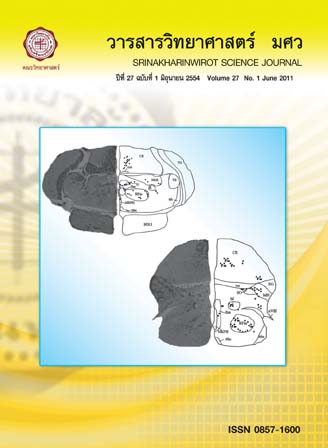การคัดแยกและจำแนกแบคทีเรียแลคติกที่สามารถสร้างแบคทีริโอซินจากแหนมปลา
Keywords:
แบคทีเรียแลคติก แบคทีริโอซิน แหนมปลาLactic acid bacteria, bacteriocin, minced fermented fish (Nham Pla)Abstract
การศึกษาแบคทีเรียแลคติก ในผลิตภัณฑ์แหนมปลาพร้อมบริโภค จำนวน 10 ตัวอย่าง พบว่ามีปริมาณแบคทีเรียแลคติก อยู่ในช่วง 1.2 x 107-4.4 x 109 CFU/g เมื่อนำแบคทีเรียแลคติก จำนวน 100 ไอโซเลท ที่แยกได้จากแหนมปลามาทดสอบการผลิตสารซึ่งมีประสิทธิภาพในการยับยั้งเชื้อทดสอบโดยวิธี direct agar spot method บนอาหาร bacteriocin screening medium (BSM) พบว่ามีแบคทีเรียแลคติกที่ยับยั้งเชื้อทดสอบได้ทั้งหมด 36 ไอโซเลทเมื่อนำแบคทีเรียแลคติกที่ให้ผลการยับยั้งเชื้อทดสอบดีที่สุดจำนวน 12 ไอโซเลท มาเลี้ยงในอาหาร MRS broth และนำไปศึกษาผลการยับยั้งเชื้อทดสอบ 21 ชนิด โดยวิธี spot-on-lawn พบว่ามีเพียง 2 ไอโซเลท ที่สร้างสารยับยั้งเชื้อทดสอบได้ คือ ไอโซเลท NP3.8 สามารถยับยั้ง Bacillus coagulans JCM 2257 และ Listeria innocua ATCC 33090ได้ดี (1,600 AU/ml) และไอโซเลท NP5.4 สามารถยับยั้ง Lactobacillus sakei JCM 1157 ได้ดี (3,200 AU/ml) สารยับยั้งที่สร้างจาก NP3.8 และ NP5.4 จะสูญเสียประสิทธิภาพในการยับยั้งเชื้อทดสอบโดยเอนไซม์ย่อยโปรตีนหลายชนิด และที่อุณหภูมิ 121 องศาเซลเซียส เป็นเวลา 15 นาที เมื่อปรับ pH เป็น 6.5 แต่สารยับยั้งที่ผลิตได้เมื่อมีการให้ความร้อนสูงยังคงแสดงประสิทธิภาพในการยับยั้งเชื้อทดสอบ เมื่อปรับ pH เป็น 3.0 ซึ่งจากคุณสมบัติของสารที่ผลิตจากแบคทีเรียแลคติกทั้ง 2 ไอโซเลท ดังกล่าวจึงยืนยันได้ว่าสารยับยั้งที่ผลิตอยู่ในกลุ่มแบคทีริโอซิน การทดสอบเอกลักษณ์เบื้องต้นโดยใช้ชุดทดสอบ API 50 CH พบว่าไอโซเลท NP3.8 มีความคล้ายคลึงกับเชื้อ Lb. plantarum (99.9%) และไอโซเลท NP5.4 มีความคล้ายคลึงกับเชื้อ Lactococcus lactis subsp. lactis (92.6%) เมื่อทำการทดลองใช้แบคทีเรียแลคติก 2 สายพันธุ์ ที่สามารถสร้างแบคทีริโอซินมาใช้เป็นกล้าเชื้อในการทำผลิตภัณฑ์แหนมปลา เปรียบเทียบกับแหนมปลาที่หมักแบบธรรมชาติ พบว่า Lb. plantarum (NP3.8) ทำให้เกิดกระบวนการหมักที่รวดเร็วที่สุด นอกจากนี้การใช้กล้าเชื้อที่สามารถสร้างแบคทีริโอซินทั้ง 2 สายพันธุ์ คือ Lb. plantarum (NP3.8) เป็นกล้าเชื้อในการหมักแหนมปลาไม่มีความแตกต่างกันอย่างมีนัยสำคัญทางสถิติ (P>0.05) ในการทดสอบด้านประสาทสัมผัสของรสชาติเปรียบเทียบกับแหนมปลาที่หมักแบบธรรมชาติ แต่แสดงผลแตกต่างกันอย่างมีนัยสำคัญทางสถิติ (P<0.05) โดยมีความชอบมากกว่าแหนมปลาที่ใช้ Lc. lactis subsp. lactis (NP5.4) เป็นกล้าเชื้อ Ten samples of retailed ready to eat minced fermented fish (Nham Pla) were investigated. It was revealed that the amount of lactic acid bacteria for these ready to eat samples were among 1.2 x 107 -4.4 x 109 CFU/g. One hundred strains of isolated lactic acid bacteria from the 10 samples of Nham Pla were tested for the production of antagonistic activity by direct agar spot method on bacteriocin screening medium (BSM). It was shown that 36 isolates were active against bacterial indicators. Among these, 12 isolates which showed the best antagonistic activity were selected to test their abilities for bacteriocin production in the MRS broth against 21 indicator strains by using spot-on-lawn method. The results implied that supernatants from only 2 isolates of NP3.8 and NP5.4 exhibited the best activity against most indicators especially Bacillus coagulans JCM 2257 and Listeria innocua ATCC 33090 with 1,600 AU/ml, and Lactobacillus sakei JCM 1157 with 3,200 AU/ml, respectively. The antimicrobial substances produced by NP3.8 and NP5.4 were lost their activities by various proteases and heating at 121OC for 15 min when adjusted to pH 6.5, but the activity of the substances was seemly heat stable when each supernatant was adjusted to pH 3.0. According to these characteristics, thus, the obtained antimicrobial substances in the culture supernatant of these 2 isolates were defined as bacteriocins. According to API 50 CHL identification system, strain NP3.8 and NP5.4 were identified as Lb. plantarum with 99.9% identity and Lactococcus lactis subsp. lactis with 92.6% identity, respectively. When used these 2 strains of bacteriocin-producing LAB as starter cultures for Nham Pla production compared to the natural fermentation samples, only Lb. plantarum (NP3.8) could be exerted most rapid fermentation period. Among the 2 bacteriocin-producing LAB as starter culture, Lb. plantarum (NP3.8) exhibited non significant (P>0.05) in organoleptically preferable to the naturally fermented product, but revealed significantly (P<0.05) more preferable than using Lc. lactis subsp. lactis (NP5.4) as starter.Downloads
Download data is not yet available.
Downloads
Published
2011-06-11
How to Cite
เมตตาเมธา น., ศิริโภค ส., & เสวตวิวัฒน์ อ. (2011). การคัดแยกและจำแนกแบคทีเรียแลคติกที่สามารถสร้างแบคทีริโอซินจากแหนมปลา. Science Essence Journal, 27(1). Retrieved from https://ejournals.swu.ac.th/index.php/sej/article/view/1456
Issue
Section
Research Article








